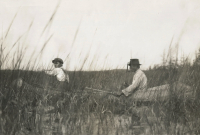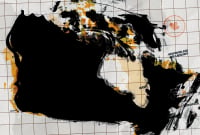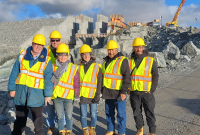Support strong Canadian climate journalism for 2025
The Lac Seul First Nation and Canada have finalized a multi-million dollar settlement agreement to compensate the nation for flooding its reserve lands without consent close to a century ago.
At a signing ceremony Friday, Lac Seul First Nation Chief Clifford Bull, alongside elders and community members met with Crown-Indigenous Relations Minister Gary Anandasangaree to sign the agreement worth $234 million. The agreement for the Northern Ontario nation was settled in March, but is now official.
“The celebration of this settlement today in our First Nation marks the end of the suffering endured by generations of our members who had to flee their homes because of the flooding that took place nearly 100 years ago,” said Chief Bull in a statement. “It has taken too long to achieve justice.
“Many of our Elders who waited patiently and fought for a fair resolution have passed on without witnessing this important event,” he said. “But today also marks the beginning of a legacy for the future generations of our First Nation and the first step towards reconciliation with our federal Treaty partner.”
The Lac Seul First Nation is the home of the Obishikokaang Anishinaabeg, and in 2021 the Supreme Court of Canada found Canada broke its fiduciary duty to the nation when it flooded the nation’s reserve land to build a hydroelectric dam without compensating for damages. Worse still, the community didn’t start receiving electricity until the 1980s — more than 40 years after the dam was built.
Construction on the dam began in 1929, and by 1934, the water was rising. More than 11,000 acres, about 17 per cent of the reserve, were permanently flooded, destroying homes, wild rice fields, and gravesites. The conduct was egregious, “even by the standards of the time,” stated the majority decision penned by Justice Andromache Karakatsanis.
That finding was strongly supported through evidence heard at the case.
“There are 688 Indians on the reserve, who are helpless to avert this calamity, and who view the future with utter dismay,” wrote H.J. Bury, a “Supervisor of Indian Timber Lands” in 1929, adding that they were being “robbed of their natural resources,” and “driven out of their homes.”
The decision rejects a lower court’s ruling that $30 million would be adequate and sets new guidelines for calculating equitable compensation for specific claims.
The agreement to now pay $234 million is a significant improvement for the nation, but it still falls short from the approximate $500 million that was initially asked for.
In 2021 when the Supreme Court of Canada ruled in the nation’s favour in the landmark Southwind v. Canada case that paved the way to Friday’s settlement agreement, Chief Bull told Canada’s National Observer a top priority for the compensation was to build a healing lodge to help community members process social issues linked to colonization..
By 1934, between one-quarter and one-third of the houses had to be moved or replaced, a government agent estimated. Over the next five years, further damage was recorded, according to the SCC decision. In 1937, Bury again alerted Ottawa to its “serious breach of faith.”
“I consider that these Indians have been very shabbily treated,” wrote Bury. “(If) it had been a white settlement, no person would have dared to flood the property without paying compensation before flooding took place.”
By contrast, non-Indigenous groups were compensated if their property was within the flood plain of the dam. The SCC decision highlights negotiated compensations with the Anglican Church Missionary Society, which received money for relocating its church and cemetery, and the Hudson’s Bay Company, which was paid for “flowage rights” over “company territory,” according to the decision.






Comments
It is an obscene level of shame and guilt that Canada has let this crime endure for so long.
Heaven bless the Supremes for knocking it down.
Now, Canada/Ontario--give justice, finally, to GRASSY NARROWS.